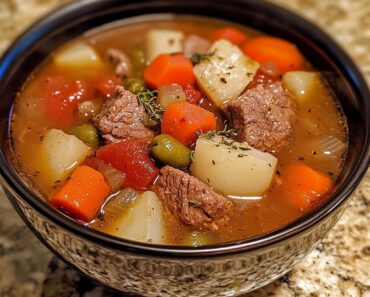
Better Than Takeout Fried Rice 😍
Introduction
Have you ever craved the comforting, savory delight of fried rice but wished you could skip the takeout and make it at home? Our Better Than Takeout Fried Rice is the perfect solution! This dish brings together the nostalgia of your favorite takeout with the freshness of homemade cooking. Originating from ancient Chinese cuisine, fried rice has been a beloved staple for centuries, evolving with various ingredients and flavors. Whether you’re looking to use up leftover rice or create a quick, satisfying meal, this recipe is a must-try. Let’s dive into making this classic dish with a twist that will have you and your family coming back for more!
Ingredients Overview
3 cups cooked white rice
Using day-old or leftover rice is ideal for fried rice as it’s slightly drier, preventing the dish from becoming mushy. Freshly cooked rice can be used, but make sure it’s cooled to room temperature for the best results.
3 tablespoons sesame oil
Sesame oil adds a distinctive, nutty flavor that is essential for authentic fried rice. It also helps in achieving the perfect stir-fry texture.
1 cup frozen peas and carrots (thawed)
This classic vegetable mix adds color, texture, and a subtle sweetness to the dish. Thawing them beforehand ensures they cook evenly.
1 small onion, chopped
Onions bring a mild sweetness and a bit of crunch. They also enhance the overall flavor profile of the fried rice.
2 teaspoons minced garlic
Garlic infuses the rice with a rich, aromatic flavor, making each bite irresistible.
2 eggs, slightly beaten
Eggs provide protein and a creamy texture, balancing the savory and umami flavors.
1/4 cup soy sauce
Soy sauce is the primary seasoning in fried rice, offering a salty and umami-rich taste that ties all the ingredients together.
Step-by-Step Cooking Instructions
1. Heat the oil
On medium-high heat, heat 3 tablespoons of sesame oil in a large skillet or wok. The oil should be hot but not smoking to achieve the perfect stir-fry.
2. Cook the vegetables
Add the 1 cup of thawed peas and carrots, 1 small chopped onion, and 2 teaspoons of minced garlic to the skillet. Stir-fry until the vegetables are tender, about 5-7 minutes.
3. Scramble the eggs
Lower the heat to medium-low and push the vegetable mixture to one side of the skillet. Pour the slightly beaten eggs on the other side and stir-fry until scrambled, about 2-3 minutes.
4. Add the rice and soy sauce
Add the 3 cups of cooked white rice and 1/4 cup of soy sauce to the skillet. Blend all the ingredients together well, ensuring the soy sauce is evenly distributed. Stir-fry until the rice is thoroughly heated, about 5 minutes.
5. Final touch
For added flavor, consider incorporating diced ham or green onions at this stage. Stir well to combine all the ingredients and serve hot.
Frequently Asked Questions
Q: Can I use brown rice instead of white rice?
A: Yes, brown rice can be a healthier alternative and adds a nutty flavor. Ensure it’s cooked and preferably day-old for the best texture.
Q: What other vegetables can I add?
A: You can add bell peppers, corn, broccoli, or any other vegetables you like. Just make sure they are chopped into small, uniform pieces.
Q: Is there a gluten-free soy sauce option?
A: Yes, you can use tamari sauce or any gluten-free soy sauce available in stores.
Q: Can I make this recipe vegan?
A: Absolutely! Substitute the eggs with tofu or simply omit them and add more vegetables or plant-based protein.
Q: How do I prevent my fried rice from being mushy?
A: Using day-old rice or ensuring freshly cooked rice is completely cooled helps prevent mushiness. Also, avoid over-stirring while cooking.
Q: Can I add meat to this recipe?
A: Yes, diced chicken, beef, shrimp, or pork can be added. Cook the meat first, set it aside, and add it back in after the vegetables are cooked.
Q: How can I make the rice spicier?
A: Add some sriracha, red pepper flakes, or a diced chili pepper for a spicy kick.
Q: Can I use olive oil instead of sesame oil?
A: While sesame oil is recommended for its flavor, olive oil can be used as a substitute.
Q: What type of soy sauce should I use?
A: Light soy sauce is typically used for fried rice, but you can also use dark soy sauce for a richer flavor and color.
Q: How do I store leftover fried rice?
A: Store in an airtight container in the refrigerator for up to 4 days.
Q: Can I freeze fried rice?
A: Yes, fried rice can be frozen for up to 3 months. Thaw overnight in the refrigerator before reheating.
Q: How do I reheat fried rice?
A: Reheat in a skillet over medium heat or in the microwave. Add a splash of water if it’s too dry.
Q: What can I serve with fried rice?
A: Fried rice pairs well with spring rolls, dumplings, or a simple stir-fry of vegetables or protein.
Q: Can I make fried rice without a wok?
A: Yes, a large skillet works just as well.
Q: Is this recipe suitable for kids?
A: Yes, it’s kid-friendly and you can adjust the seasoning to suit their taste.
Q: Can I use fresh vegetables instead of frozen?
A: Yes, fresh vegetables can be used. Ensure they are chopped and cooked until tender.
Q: How can I add more protein to this dish?
A: Add more eggs, tofu, or cooked meat like chicken, beef, or shrimp.
Q: Can I add pineapple to my fried rice?
A: Yes, pineapple adds a sweet and tangy flavor that complements the savory ingredients.
Q: What’s the best way to chop the vegetables?
A: Chop vegetables into small, uniform pieces for even cooking.
Q: Can I use garlic powder instead of minced garlic?
A: Yes, but fresh minced garlic provides a better flavor. Use about 1/2 teaspoon of garlic powder as a substitute.
Helpful Tips
Tip 1: Use day-old rice for the best texture. Freshly cooked rice tends to be too soft and can make the dish mushy.
Tip 2: Thaw frozen vegetables before adding them to the skillet to ensure even cooking.
Tip 3: Chop vegetables evenly to ensure they cook at the same rate.
Tip 4: Preheat the skillet before adding the oil to get a perfect stir-fry.
Tip 5: Use a large skillet or wok to avoid overcrowding and to allow even cooking.
Tip 6: Scramble the eggs separately to keep them from becoming too mixed into the rice.
Tip 7: Don’t over-stir the rice while cooking to avoid breaking the grains.
Tip 8: Season gradually with soy sauce and adjust to taste to avoid over-salting.
Tip 9: Add ingredients in stages to ensure everything is cooked properly.
Tip 10: Experiment with different oils like peanut or vegetable oil for varying flavors.
Tip 11: Use high heat for quick cooking and to achieve that perfect fried texture.
Tip 12: Add a splash of soy sauce at the end if the rice seems dry.
Tip 13: Use a spatula or wooden spoon to stir-fry for better control.
Tip 14: Add a bit of butter for extra richness and flavor.
Tip 15: Garnish with green onions for a fresh, crunchy finish.
Tip 16: Serve immediately for the best taste and texture.
Tip 17: Adjust seasoning based on your dietary preferences (low-sodium soy sauce, etc.).
Tip 18: Add a splash of water if the rice starts to dry out while reheating.
Tip 19: Cook meat separately to ensure it’s fully cooked before adding to the rice.
Tip 20: Have fun experimenting with different vegetables, proteins, and seasonings to make the recipe your own!
Storage Tips
- Store leftovers in an airtight container in the refrigerator for up to 4 days.
- Freeze fried rice in a freezer-safe bag or container for up to 3 months.
- Label the container with the date to keep track of freshness.
- Thaw frozen rice in the refrigerator overnight before reheating.
- Reheat in a skillet over medium heat for the best texture.
- Microwave leftovers in a microwave-safe dish, covered, with a splash of water to prevent drying out.
- Divide into portions before storing to make reheating easier.
- Add a bit of soy sauce when reheating if the rice seems dry.
- Store in smaller containers for quicker cooling and reheating.
- Avoid reheating multiple times to maintain the quality and safety of the rice.
Recipe Secrets
- Day-old rice is key to achieving the perfect texture.
- Sesame oil adds a distinct flavor that’s essential for authentic fried rice.
- Thaw frozen vegetables for even cooking.
- High heat is necessary for a proper stir-fry.
- Don’t overcrowd the skillet to allow the rice to fry rather than steam.
- Scramble the eggs separately to keep them from becoming too mixed into the rice.
- Use light soy sauce for seasoning and dark soy sauce for color.
- Butter adds richness and enhances the flavor.
- Green onions add a fresh, crunchy finish.
- Experiment with different proteins like shrimp, chicken, or tofu.
- Add a splash of soy sauce at the end if the rice seems dry.
- Use a spatula or wooden spoon to stir-fry for better control.
- Garnish with fresh herbs for a burst of flavor.
- Cook meat separately to ensure it’s fully cooked before adding to the rice.
- Add a bit of water if the rice starts to dry out while reheating.
- Season gradually to avoid over-salting.
- Serve immediately for the best taste and texture.
- Chop vegetables evenly to ensure they cook at the same rate.
- Preheat the skillet before adding the oil to get a perfect stir-fry.
- Have fun experimenting with different ingredients to make the recipe your own!
Conclusion
Our Better Than Takeout Fried Rice is not just a recipe; it’s an experience that combines the convenience of takeout with the satisfaction of homemade cooking. With detailed steps, valuable tips, and a wealth of FAQs, you’re well-equipped to create a delicious, versatile dish that’s perfect for any meal. Whether you’re a seasoned cook or a kitchen novice, this recipe is designed to be easy, fun, and utterly delicious. Happy cooking!







